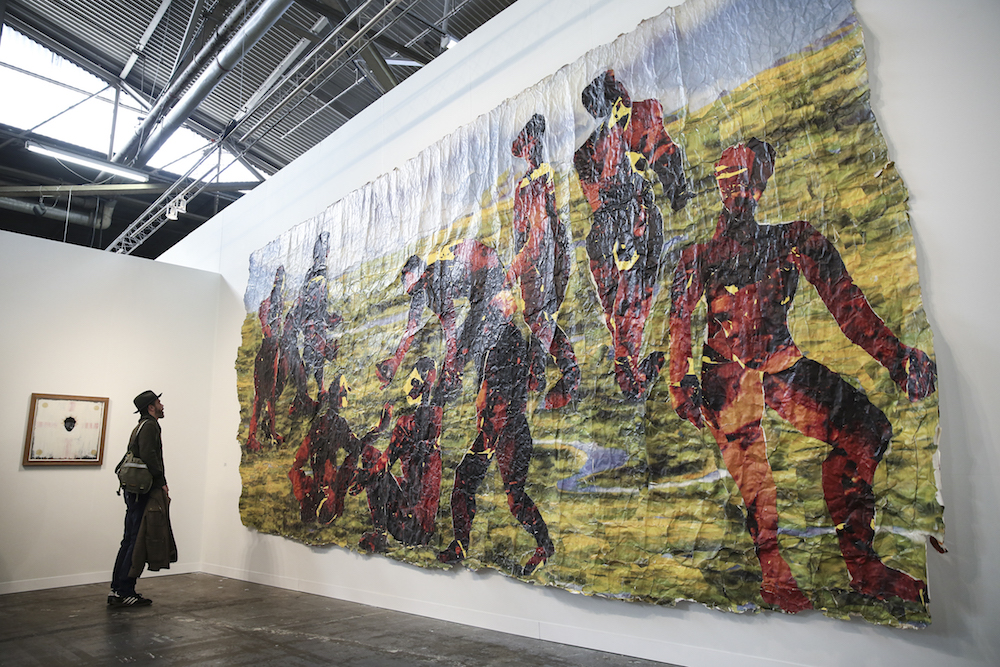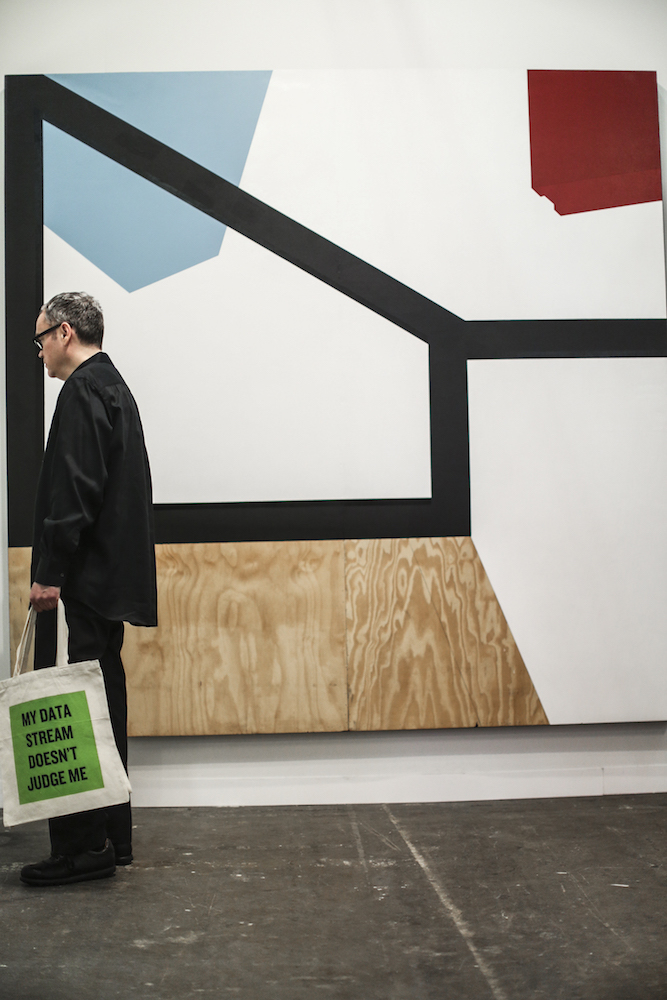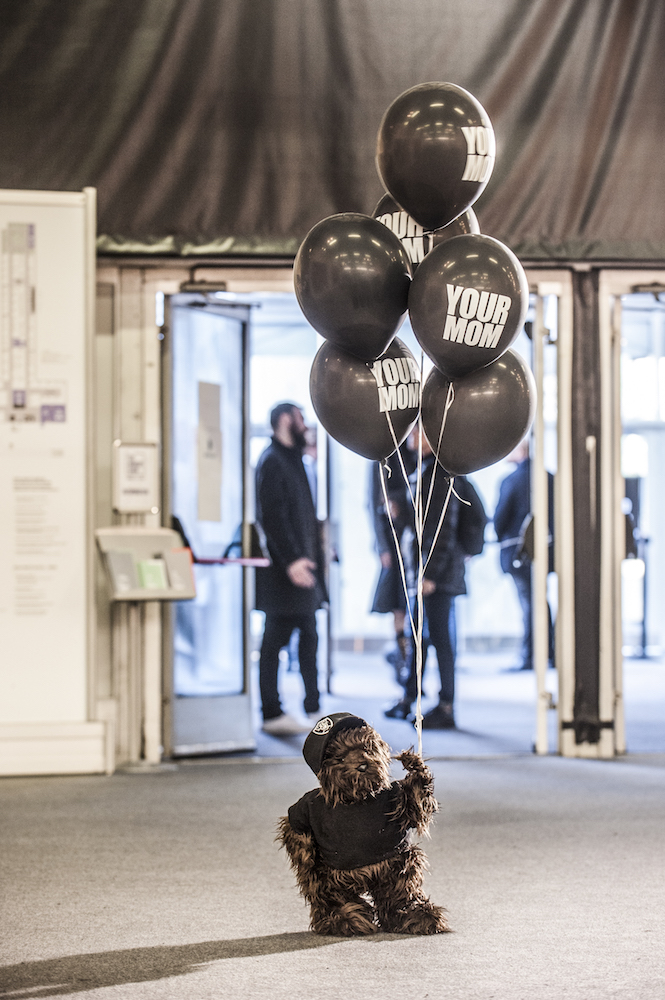In addition to Bio2Watt's Bronkhorstspruit plant
Manhattan isn’t Paris, but for a few hours in early March an overcrowded exhibition hall on the Hudson River resembled the la-di-da Parisian art world that Honoré Daumier lampooned with such verve in his drawings more than 150 years ago.
Whiskers, top hats and matronly dresses may now be redundant at art fairs, but the polished, mostly white crowd at the VIP opening of the annual Armory Show – where 205 galleries from 36 countries showed work for sale in a vaulted hall – possessed the same self-congratulatory Daumier haughtiness.
I read afterwards that David Byrne, Anderson Cooper and Jon Bon Jovi were there. Missed them. Jo’burg dealer Monna Mokoena, whose Gallery Momo was showing work in the Armory’s contemporary pavilion for the first time, told me Chris Rock had visited his display of portrait photos by Mary Sibande and Ayana V Jackson. Missed him too.
I did, however, spot a silvery old man with blue jacket and camera being interrupted while working. “I love your work,” a lady with Nancy Reagan hair gushed. Bill Cunningham, the 86-year-old New York Times fashion photographer and people watcher, would have none of it. He scuttled away, only to be swooped on by another admirer.
Alongside the famous, the Armory also attracted the famously rich. They included cosmetics mogul and mega-art collector Ronald Lauder, of the Estée Lauder dynasty, and Artur Walther, a former Goldman Sachs investment banker turned Africa-interested photography collector.
Despite its over-subscribed VIP day, it is plebs – not toffs – who make up the bulk of the Armory’s 65 000 visitors every year. In 2014 more than a million people visited the world’s top 22 fairs, most of them in the United States and Europe.
Unlike museums, where looking is restricted to coy appreciation, art fairs aim to translate feverish gazes into sales. The European Fine Art Foundation estimates that the world’s 180-odd major international art fairs sold an estimated R167-billion in 2014, which is R10-billion more than Eskom’s capital expenditure budget over the next three years.

An Armory Show attendee looks at a paper construction by Kay Hassan. (Kelly Taub/ BFA.com)
South Africa’s two biggest fairs don’t even register a ripple in the river of wealth. Sales at the Joburg Art Fair, founded in 2008, have flatlined at about R25-million, and the rejigged Cape Town Art Fair sold R20-million at its third edition.
Despite their novelty locally, art fairs are hardly new. Art Basel, which hosts annual events in three cities (Basel, Miami and Hong Kong), was established in 1970. The first Armory was held in 1994, although its name is derived from the storied 1913 art salon in a New York armoury where Daumier-like men in hats rubbed up against the new and modern.
But it was only after 2000 that these “event-based buying experiences”, as Armory director Benjamin Genocchio characterises fairs, truly came into their own. Despite their cultural ascendency, art fairs are not democratic spaces – they are profit-motivated businesses where stringent selection criteria are used to weed out those capable and creative enough to pay to play.
“You have to take the big artists, otherwise it doesn’t pay,” Linda Givon, the retired founder of the Goodman Gallery, told me in 2008. It cost her about R1-million a year to participate in the Basel and Miami Beach iterations of Art Basel, she said, which is cheap at today’s prices.
Booth rental at the Armory, which this year included contributions by Goodman Gallery, Stevenson and Gallery Momo, was more than R550 000. The Goodman, now owned by Liza Essers, hedged its bets by showing nine ink drawings by William Kentridge alongside works by two Zimbabweans, painter Misheck Masamvu and multimedia artist Kudzanai Chiurai. Chiurai created a gilded shopfront display titled Emporium that included a mannequin fitted with printed cotton cassock and gold-plated shopping trolley. It was priced at R1.3-million.
Stevenson took a large Zander Blom abstract canvas, priced at R340 000, and a dappled painting on paper by Moshekwa Langa, priced at R305 000. The gallery sold out of an edition of photographic self-portraits by Zanele Muholi, although similar Muholi works, priced at about R120 000, could be bought from her New York dealer, Yancey Richardson Gallery.
Art dealing is a business built on trust; location still matters. With limited financial means to expand their footprints internationally, particularly into premium locales such as London or New York, South African dealers such as Goodman, Stevenson and Whatiftheworld are increasingly sharing their artists with rival dealers in key European and American markets.

Serge Alain Nitegeka’s work on display at the Armory Show. (Kelly Taub/ BFA.com)
Nicholas Hlobo, who came up through Stevenson and made a big splash at the 54th Venice Biennale in 2011, is currently presenting his first New York solo show with Lehmann Maupin, a well-regarded dealership that also represents Robin Rhode. And Serge Alain Nitegeka, Stevenson’s Burundian-born sculptor, opened his solo show at Marianne Boesky Gallery in Chelsea on March 17. Boesky, who launched the international career of Japanese pop artist Takashi Murakami, first tested the waters with Nitegeka two years ago at the Armory.
The uptick in the market for contemporary African art owes a great deal to the trailblazing cultural activism by curators such as Okwui Enwezor, art historians such as Salah Hassan and Olu Oguibe, institutions such as the October Gallery in London, and patient dealers such as Givon and New Yorker Jack Shainman.
A large untitled paper construction from 2003 by Jo’burg artist Kay Hassan, on offer for R4.6-million, dominated Shainman’s stand at this year’s Armory. Trying to get a word with him was hopeless. “Jack! Jack! Jack!” voices pleaded constantly at his booth. Shainman, who first started dealing in 1984 from a space in Washington, DC, is a key player.
Hassan aside, he also represents local artists Anton Kannemeyer, Zwelethu Mthethwa and Claudette Schreuders, as well as the acclaimed Ghanaian sculptor El Anatsui, ranked this continent’s most important artist after Ethiopian-born painter Julie Mehretu and William Kentridge in the inaugural African Art Market Report.
Shainman’s diverse artist list, which spans Africa, Southeast Asia and North America, might be defined as post-white. His dealership’s worldly and race-aware position is gaining traction in an art market that, in the main, remains lily-white – even in Barack Obama’s US.
While there weren’t any memes suggesting #ArmorySoWhite, the notion of a post-white art world is still far off. But things are changing, at least in the US. “After decades of spotty acquisitions, undernourished scholarship and token exhibitions,” reported the New York Times last year, “American museums are rewriting the history of 20th-century art to include black artists in a more visible and meaningful way than ever before, playing historical catch-up at full tilt, followed by collectors who are rushing to find the most significant works before they are out of reach.”
The Armory’s decision to devote its annual invitational focus section to “the artistic developments and manifold narratives arising from African and African Diasporic artists”, as they positioned editor Julia Grosse and art historian Yvette Mutumba’s selection from 14 invited galleries and special projects, speaks to this shift.

Ed Young’s work at the Armory, appearing under the banner “All So Fucking African.” (Kelly Taub/BFA.com)
Cape Town galleries Blank Projects, Whatiftheworld and Smac were invited to participate with a solo presentation. All were well received.
Blank sold all of 2015 FNB Art Prize winner Turiya Magadlela’s pantyhose paintings, including an untitled triptych for R200 000, to the Studio Museum in Harlem. Similarly, Smac, which has galleries in Stellenbosch and Cape Town, reported strong sales of photographs depicting Kenyan artist Cyrus Kabiru wearing his idiosyncratic handmade art glasses, priced individually at R84 000.
For much of the past two decades, the standard pathway to international success for a local artist has been through exposure at a biennale. Art fairs are now beginning to play a similar role. In turn, art is changing to reflect this system of patronage.
Just as there is a category of work pejoratively spoken of as “biennale work” (think sprawling in form, anti-consumerist in material, left-leaning in ideological compass), so fairs are sponsoring a new kind of art. The worst examples are simply ersatz financial instruments dressed up as clever interior design. But art fairs are also spaces of possibility.
Take Ed Young. One could viably argue that art fairs, which cater to the preening vanities of arriviste art buyers, are perfectly suited to this Smac artist’s media savvy brand of attack. Insouciance is a powerful aphrodisiac. Best known for his Maurizio Cattelan-like sculptural self-portraits at the Joburg Art Fair, Young created a large banner reading: “All So Fucking African” for his Armory appearance. Beneath it he placed a black teddy bear in an Oakland Raiders cap holding a bunch of black balloons featuring the words: “Your Mom”.
“Ho-hum!” some might sigh. The New York Times nonetheless praised his “impudent verve”.
The market for African art is still minuscule. In 2014, auction sales of African art totalled $31-million, according to the African Art Market Report. To put things in perspective, this was one-third of the value of a single Andy Warhol work sold for $81.9-million that year. Nevertheless, there is talk internationally of “an African art market bonanza” (Artnet), with the freighted verb “scramble” (Bonhams) even being used. Artists looking to survive this neo-whatever raid by the grandchildren of Daumier’s aristocratic elites will require all their wits about them, and then some.